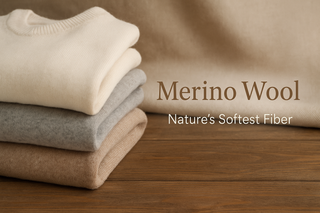Wool is considered by most people as something bulky, heavy, and maybe even a little itchy. But merino wool has changed this perception. This distinct wool fiber has been loved since ages, and even today it remains popular among people who want their wool products to feel soft and breathable.
A Quick Look Back: Merino’s History
Merino wool has a great history. The Merino sheep, that produces fine wool, were first bred in Spain around the 12th century. For a long time, Spain kept this breed of sheep exclusive, and owning or trading them outside the country was almost impossible. Later, merino sheep spread to places like the United States and South Africa, where they thrived in new climates and expanded the global production of merino wool fibers. Today, these regions remain some of the biggest producers of merino wool.
How is Merino Wool Different?
Unlike rougher kinds of wool, merino wool fiber is amazingly fine, so fine it’s actually thinner than a strand of human hair. Hence merino wool garments feel soft and smooth on the skin instead of itchy or scratchy.
Here’s what makes merino wool different from other varieties of wool:
- Softness: The wool fibers are so delicate and flexible that they bend easily, which is why they feel so gentle and comfortable against the skin.
- Breathable: It keeps you warm in the cold but cool in the heat, ideal for base layers or outdoor wool clothes.
- Odor resistant: Unlike synthetic fabrics, merino naturally resists smells, even after long use.
- Durability: Even though it is fine, merino fibers are strong and built for endurance.
Benefits of Merino Wool
The benefits of merino wool are what make it a favorite for both every day and active wear:
- Comfortable against skin: No itch, just softness.
- Temperature regulation: Ideal for summer hikes or winter layers.
- Odor resistant: Can be worn multiple times without worrying about odor.
- Lightweight and warm: Not too heavy but warm.
- Versatile: Merino wool is generally ideal for stylish sweaters and other wool clothes.
Types of Merino Wool
Merino wool is available in different varieties and usually classified by the thickness of its fibers, that is measured in microns:
- Fine Merino: 17–20 microns, used for luxury fashion and next-to-skin clothing.
- Medium Merino: 20–24 microns. Used for sweaters and daily wear.
- Strong Merino: 24–27 microns. Used for carpets, upholstery, and durable fabrics.
- The finer the fiber, the softer it feels. That’s why the type of merino you go for really depends on what you need, something luxurious, something tough and durable, or a balance of both.
Everyday Uses: From Fashion to Function
Since merino is highly adaptable, it’s used in many kinds of wool products, from everyday clothing to performance wear:
Merino wool garments such as sweaters, cardigans, and scarves for stylish wear.
Base layers and activewear for hikers, runners, and travellers who require breathable, moisture-absorbing comfort.
High-quality wool clothes for everyday warmth that do not feel heavy.
Conclusion
Merino wool is where history, nature, and comfort meet. Loved since the 12th century, merino still shows up everywhere today, from everyday knits to true performance layers. It’s soft like human hair, breathes well, and naturally keeps odors in check. For everything from everyday warmth to outdoor mileage, merino is a smart buy that stands the test of time. Merino is a smart, long-lasting pick that stays in style.
Frequently Asked Questions
1. How does merino wool differ from other types of wool?
Merino is a variety of wool that is finer and softer. Since the fibers are thinner than human hair, they feel smooth against the skin and do not itch.
2. Is merino wool good for activewear?
Yes. Merino wool is lightweight, breathable, and odor resistant, hence is perfect for activewear.
3. Does merino wool last long?
Yes. Even though it's fine wool, it’s strong. With the appropriate care, your merino wool garments can maintain shape and last for many years.
4. Is merino wool sustainable?
Yes. Merino is a natural, renewable fiber, and the best part is that it breaks down on its own over time, unlike synthetic fabrics that stick around as plastic waste.


